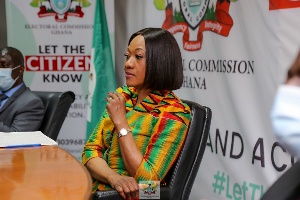 EC Chairperson, Jean Adukwei Mensa
EC Chairperson, Jean Adukwei Mensa
The book “How to lie with statistics “written by Darrell Huff in 1954 seems to be more relevant these days. Statistics can be misused either by accident or design in everyday life.
There are quite a few articles of faith that are based on shaky and sometimes non-existence foundation.
People with mathematical knowledge can find out about how numbers can be manipulated by accident or design to trick the public into making false conclusions and when they are being fed misleading numbers.
As statistics is increasingly being used for managing public opinion, the ability to spot bad statistics is extremely important to everyone and can literally be a life-saver.
Nowadays every claim is accompanied by statistics to validate them. When both contradicting claims have supporting studies behind them, it is important to question whether some manipulations have taken place.
The interpretations of statisticians may not be the same as what the public understands. In order not to fall into the trap of manipulation we should navigate through these numbers and percentages, to analyse and have a second thought before arriving at a conclusion.
The dispute of the results of just ended election in Ghana is a point in question. The presidential election was won by the incumbent president by 515,524 votes and nobody is disputing about this figure.
The percentage votes of the winner and loser has created arguments among the winning NPP party and the losing NDC party. The declaration by the Electoral Commission that the NPP presidential candidate obtained 6730413 representing 51.595%which makes him the winner whilst the NDC candidate received 6214889 representing 47.366% has caused arguments.
The argument is about one constituency which was not included in the calculations because according to the Electoral Commission counting was still going on and even if the votes of that constituency is added to the candidate of the NDC, the results will not change.
The total number of votes in the elections was 131,194,60. The Techiman constituency vote is 128,018.
According to the NDC statistician Dr Aheto, there will be a run-off if the Techiman votes is added to the votes. His percentage figure for the winner is 49%and the loser is 46%. But a senior lecturer of the department of statistics university of Ghana claimed that there will never be a run-off.
Louis Asiedu explained that the change in the percentage of votes for both candidates will be insignificant because the winner will have percentage votes of 50.807 and the loser will have percentage votes of 47.867.
The incumbent president is still the winner. I carried out my own calculations as somebody who is not a statistician but with qualifications in a discipline that requires statistical understanding and the results are similar to the percentage votes of Louis Asiedu which is 50.807 for the winner and 47.880 for the loser.
This shows that statistics can be misused and errors in the interpretation of statistics may create incorrect conclusions.
It should be noted that there are so many ways that people could deliberately lie whilst simultaneously giving an air of credibility to whatever they are purporting.
I am not saying that Dr Aheto lied but he got his figures wrong.He used the figures for the Techiman constituency as 124000 which is not correct because the correct figure is 128018.
This shows that statistics can be misstated. The courts will look at all these pieces of evidence and kick the case out of court.
Unfortunately, the loser will blame the court for siding with the winner which is always the case.